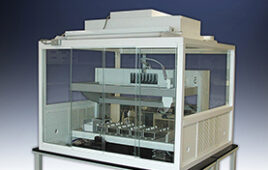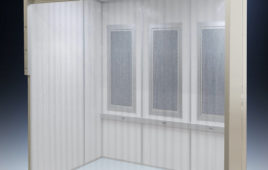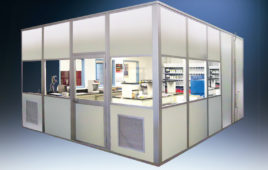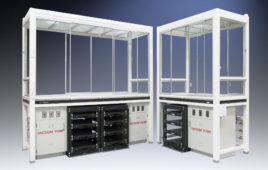For more than 50 years, an increasingly wide variety of processes and products owe their existence and success to a cleanroom or similar controlled environment. Our experiences, livelihoods, and health have all directly benefitted from things that, in ways large and small, came out of a cleanroom. Entire new industries and markets have emerged just for cleanrooms themselves, and cleanroom related products, in addition to the products that are made within them. Cleanrooms have become so commonplace in many industries that they have lost the novelty they once had — which has led to a familiarity that can have disastrous consequences.
As applications for manufacturing in cleanrooms grew in the 1980s and early ‘90s (think PCs), cleanroom and supporting technologies (ultrapure gas and water systems, wall and floor materials, garments, wipes, gloves, etc.) grew with them in a leapfrog fashion. At the time, the pace of innovation and change was dramatic, and those responsible for operating and maintaining the cleanroom environments had to intimately understand contamination control and its practice. Dedicated contamination control engineers were common, and their sole job was overseeing the cleanroom proper and ensuring that operations, materials, and behavior protocols would not compromise the cleanliness of the cleanroom. Importantly they realized that the cleanroom itself, rather than simply being a clean space in which critical equipment was operated, was in fact an integral and critical part of the production process.
 Advances in cleanroom and supporting technologies certainly still occur, but not at the pace they had, and not as broadly applied or required as before. The result is that today, while the specific activities and processes within a cleanroom may be nothing short of science fiction, it is likely the cleanroom itself was pre-existing, or newly built based on tried-and-true configurations and approaches.
Advances in cleanroom and supporting technologies certainly still occur, but not at the pace they had, and not as broadly applied or required as before. The result is that today, while the specific activities and processes within a cleanroom may be nothing short of science fiction, it is likely the cleanroom itself was pre-existing, or newly built based on tried-and-true configurations and approaches.
Personnel who have deep understanding of contamination control are increasingly uncommon, as the veterans of the period of cleanroom innovation have retired or moved on, and those coming into responsibility for contamination control are tasked with many other responsibilities at a time when the operation of cleanrooms has become so familiar as to be nearly rote procedure. There is risk, however, in that such familiarity can often lead to a complacency that jeopardizes effective and robust cleanroom operation and necessary contamination control.
One of the most important familiar requirements within cleanrooms is the physical cleaning of the cleanroom itself to maintain necessary contamination control. In the majority of processes conducted in cleanrooms, deficient or ineffective janitorial cleaning of the room itself poses significant risk to human health (in the case of pharmaceutical production and compounding pharmacies) and production yield loss and related cost (in the case of semiconductor fabrication).
In the highly regulated field of pharmaceutical and medical device manufacturing, one need only peruse the public record of FDA audit findings to regularly read examples indicating lapses in cleanroom cleaning; tragic events several years ago traced to cleaning deficiencies at a compounding pharmacy in New England have resulted in more stringent oversight of the entire compounding pharmacy industry.
Effective and consistent cleaning of a cleanroom is neither simple nor easy. It has been said that cleaning the cleanroom itself is the most difficult job in the cleanroom, and those that are tasked to do so on a daily basis would likely agree. The task is made all the more difficult because it requires removal and control of contaminants that are invisible to those doing the cleaning — similar to trying to repaint a ceiling, wall, or floor with the exact same color paint, with almost no way to tell what has just been painted. What is required is useful and effective tools with which to clean, and a consistent method or protocol to use them.
Maintaining a clean environment is greatly facilitated if the sources and types of contaminants are understood. Contamination sources can be divided into five general categories:
• Personnel
• External environment
• Materials used in processes/products
• Equipment operation
• Maintenance activities
Of these, personnel are by far the single largest and most prolific sources of contamination, shedding thousands of bacteria carrying particles each minute, as well as a variety of hairs, fibers, oils, and saliva. Controlling these contaminants requires diligent adherence to meaningful protocols and methods for operator gowning and behavior within the cleanroom. When personnel behavior is appropriate and they are under suitable contamination control, a stable (ideally, low) baseline of contamination load within the cleanroom may be reached, facilitating greater contamination control with less effort via janitorial cleaning. However, when cleaning the cleanroom, we are mostly cleaning up after ourselves.
How can janitorial staff hope to consistently and effectively clean something they cannot see? The answers lay in using the right cleaning tools in ways that maximize cleaning consistency, whether the task is removing particulate contamination or applying disinfectant solutions.
Since the advent of the cleanroom, wipes (used by hand) have been the most common tool for cleaning surfaces. Other products have been developed to either meet specific needs of the cleanroom or mini-environment, or to simplify and expedite
the cleaning activity. The result is a wide variety of mops for floors, walls, and ceilings; tools for cleaning biosafety cabinets, isolators, and unidirectional flow hoods; and devices for cleaning vinyl strip curtains and behind, under, and around immovable
pieces of equipment.
In many cases, these tools enable operators to reach and access surfaces that would be very difficult to adequately clean by hand — the far corners of a biosafety cabinet, or the high walls of a satellite assembly cleanroom, for example. So even though an operator has the conscientious desire to properly clean a difficult surface, physical limitations can make doing so almost impossible. The result is often inconsistent and/ or inadequate cleaning or disinfection, and the associated risks of inadequate contamination control. Using specifically chosen cleaning tools and other cleaning aids enables proper cleaning and minimizes cleaning inconsistency.
Whether cleaning a surface involves wiping by hand, or using a more effective tool to aid in cleaning, it is inescapable that how the wipe or tool is used directly affects the effectiveness and consistency of cleaning and contamination control. Proper and consistently applied operator behavior and cleaning protocols (the codified details of how, when, and where cleaning is performed) are critical to effective contamination control in any cleanroom. Great diligence is required, and frequent re-training is beneficial to avoid complacency and the encroachment of poor and inefficient cleaning practices.
By recognizing the ongoing need to effectively and consistently clean the cleanroom, avoiding complacency at every turn, and using the correct cleaning tools and materials effectively, those who are responsible for contamination control can keep the largest piece of production equipment operating cleanly and properly.
David P. Nobile is Senior Technical Service Engineer for Contec Inc. He has more than 32 years’ experience developing products and processes for cleanroom and other industrial applications, and holds several patents. Nobile is chairman of the IEST Working Group 004 to revise the IEST RP-004 test methods “Evaluation of Wipers Used in Cleanrooms and Other Controlled Environments.” www.contecinc.com
This article appeared in the May/June 2015 issue of Controlled Environments.




